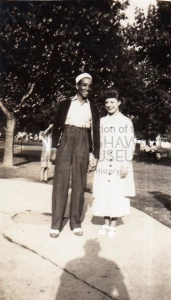By Jennifer Weymark, Archivist
What is implicit bias?
The Kirwan Institute for the Study of Race and Ethnicity at Ohio State University defines it as such: also known as implicit social cognition, implicit bias refers to the attitudes or stereotypes that affect our understanding, actions, and decisions in an unconscious manner. These biases, which encompass both favorable and unfavorable assessments, are activated involuntarily and without an individual’s awareness or intentional control.
I have previously written about implicit bias in the development of the Oshawa Museum’s archival collection. At that time, I was looking at how absences in the collection due to the implicit bias of those collecting has created an incomplete history of our community. The collection contains a great deal related to early industrialists, politicians, and the wealthy, with little related to the everyday person, women, or people of colour. This is true of archival collections across Canada and the Western world. It has been recognized, and archivists are working to address the issue and find ways to develop collections that better represent the entirety of our communities.
It wasn’t until this past summer that I became aware of a bias of my own. I was working through the Lowry Collection, an amazing series of photographs of Lakeview Park during the 1930s that also happens to be one of our most racially and ethnically diverse photograph collections, that I finally noticed an issue with our database descriptions.
The photograph I was looking at was one of my favourites. It shows a young couple, hand-in-hand, posing for the camera. In the shadows you can see the outline of the photographer holding their brownie camera, and the popularity of the park is seen all around the subjects. The photograph is unusual, particularly for the time period, in that it is a young Black man and a young white woman holding hands. This is where I finally took note of something I should have noted long before.
The description is as follows: “B&W photo removed from a damaged photo album. Image is of a young African-Canadian and a young woman standing beside one another. The man is wearing a white hat and shirt and dark trousers and sweater. The young woman is wearing a long white coat. The shadow of the photographer is visible. Lakeview Park. Circa 1930s”.
Do you see the implicit bias? The assumption made that, unless otherwise noted, the people in the images are white. This is an example of implicit bias by the author of the database notation, and it is throughout the accession record for this collection and the entire archival collection.
As part of our work in the archival field, archivists are working to examine archival descriptions for implicit bias, or in some cases outright racism, and begin the work to remove the bias and make the descriptions inclusive. In fact, as part of the programme committee for the 2021 Archives Association of Ontario Conference, I had the privilege of reading several paper proposals examining this issue within different institutions and how they are working to address it.
As for me, I began addressing this starting with the Lowry Collection. Archival descriptions will be edited to remove the implicit bias, and a notation that the description has been changed and the reasoning behind the editing process added to the record.


One thought on “Implicit Bias and the OM’s Archival Collection”